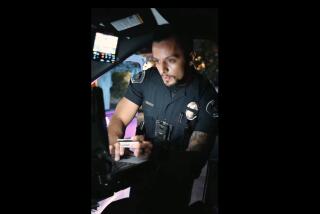LAPD Trains for Head Shot as a ‘Last Resort’
The Los Angeles Police Department, reacting to increasingly dangerous confrontations in the field, is training its officers to shoot for a suspect’s head “as a last resort” when their lives are in danger, police officials said Thursday.
The new technique, instituted in November, is a departure from previous training in which officers concentrated their fire on a suspect’s “largest body mass,” typically the torso. Police stressed the new training does not reflect any change in the department’s shooting policy, which allows officers to fire only when lives are in danger.
Training that includes a head shot has been in place in the Los Angeles Sheriff’s Department for several years, a sheriff’s spokeswoman said.
In a press conference and shooting demonstration Thursday afternoon at the Police Academy range, Police Cmdr. Bernard Parks said the new training is designed “to broaden the options” of officers in the field “so they don’t just shoot into the body mass until they run out of bullets.” The rising sophistication of criminals, some of whom may wear bulletproof vests, has made the head shot an important option, he said.
In the training demonstration, shooters were instructed: “Remember, the head shot is a last resort if the suspect is wearing body armor and continues to be a threat.”
At greater distances, shooting instructors fired only into the chest of a silhouette target. When they moved to the closest position, within seven yards of the target, they finished off two shots to the chest with one to the head.
Three instructors used the standard .38-caliber revolver And a 9-millimeter Baretta and a 9-millimeter Smith & Wesson, both semiautomatic.
As well as combatting suspects wearing body armor, the head shot may also prove useful “if the suspect is on PCP or just psycho,” said training Officer Mark Litzinger.
“If you put two rounds in his chest and he keeps coming at you,” he said, “then you take out the computer,” referring to the brain.
‘Drastic Change’
An attorney with the American Civil Liberties Union, Catherine Leslie, said the new training represents a “drastic change” in police policy thatwould lead to the deaths and injuries to bystanders, as well as suspects.
“It’s much easier to miss when you’re aiming at the head,” Leslie said. “We believe it is the responsibility of the police to protect the public and to protect themselves. It is not their responsibility to execute criminal suspects.”
A five-year study of officer-involved shootings resulted in the new marksmanship training, which corresponds more closely to field situations, Parks said. In addition to the head shot, the new training requires officers to fire within shorter time spans, change positions and reload, re-holster and re-sight their weapons.
“The whole premise is to prepare for the field. . . . We are trying to keep our officers ahead of the situation, rather than lagging behind,” the commander explained.
Asked whether the new training could result in more shots being fired by officers, thus increasing the danger to bystanders, Parks replied: “I think it will be less dangerous, because officers will become more proficient. Officers will hopefully shoot less often.”
Academy Range
The department’s 6,000 patrol officers are required to re-qualify every two months at the academy range. Initially, the head shot is not being graded into their score and will probably be added in the summer, Parks said.
Los Angeles police officers generally hit only about one-third of their targets in the field and have been engaged in an increasing number of shooting incidents, Parks said.
In 1985, there were 178 incidents in which police fired their weapons. Sixty-five suspects were hit, including 21 who died. Ten officers were wounded and one officer was killed in gun battles.
More to Read
Sign up for Essential California
The most important California stories and recommendations in your inbox every morning.
You may occasionally receive promotional content from the Los Angeles Times.









